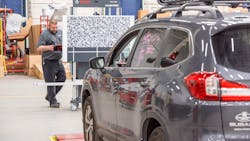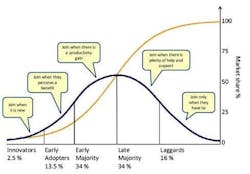I recently participated in a filmed panel discussion on the topic of advanced driver assistance system (ADAS) work as part of collision repair. The event was orchestrated by CCC and hosted by I-CAR. Other panelists included a vehicle manufacturer representative and a representative from a large collision repair organization. There, I learned that currently only about 50 percent of CCC estimates include a line item for “scan,” and only about 8 percent include a line item for “calibrate.” While we don’t know specifically how many of those vehicles estimated should have had diagnostic scans/calibrations based on vehicle manufacturer repair procedures, all of the participants agreed that it is obvious that these numbers are pathetically low.
In the last five or more years, we’ve seen a tremendous increase in the number of ADAS systems that are standard or commonly optioned on new vehicles, many of which are required to be calibrated after certain collision repairs, again based on manufacturer repair procedures and position statements and other documents such as job aids. I work for LaMettry’s Collision in Minneapolis, a regional MSO with 10 collision repair locations. It has been our policy for at least six years that every vehicle receiving a collision repair is scanned both pre- and post-repair. Before that, we required at least one diagnostic scan. And today, it seems like many, perhaps most, of our vehicles in repair need some sort of calibration. Even on vehicles that have ADAS and do not require a calibration per repair procedures, at very least a drive with an experienced/competent person who engages ADAS systems to test for proper operation.
This leads to the questions, “Why don’t more shops scan and/or calibrate in more situations?” and “Why aren’t we changing at the rate vehicles are changing?”
Embracing new ideas, processes, or products
These are the typical steps when looking at new things:
1: Awareness
2: Research and discovery
3: Evaluation and decision-making
4: Trial
5: Adoption or rejection
Since I, and the company I work for, embrace ADAS, I can only speculate why others don’t, based on assumption as well as some anecdotal information I get when interacting with other repairers.
I would hope that shops are “aware” of the issue. If not, I suggest they shouldn’t be working on newer vehicles until they are.
I think most have done some “research and discovery,” though due to cost of new equipment and training, and perhaps some perception that the issue is exaggerated, I suspect many shops haven’t moved past this step. Perhaps they’ve sent some ADAS work to a sublet source when absolutely necessary, such as addressing a dash light or an obvious function issue. I think many shops are still evaluating and working on decisions. At industry conferences and elsewhere, I am often asked about equipment and training choices, indicating shops are still in steps two or three.
And unfortunately, some insurers question some of the necessity of this work, and in some cases are reluctant to cover the costs unless overtly proven to be necessary. I sometimes hear shops say that they won’t perform this work unless they are paid for it. Uninformed insurers working with uninformed repairers is a sad and scary combination, especially for the uninformed vehicle owner. But this can be overcome. I know from experience that an informed repairer can typically use manufacturer information to persuade insurers to cover costs. In other words, instead of a repairer complaining that they won’t get paid and thus won’t perform the work, it is better to perform the work and prove the necessity. If not immediately, it will eventually result in the change our industry needs, and our customers deserve. We as repairers should be taking the leadership role here.
The innovation adoption curve
Roger’s theory of innovation suggests that we each adopt innovations in different way and at different rates. Though if the innovation provides value, we eventually get to a point of universal acceptance. (Everett M. Rogers (1931-2004) is the most recognized name associated with the diffusion of innovations. Rogers was among the first to recognize the study of diffusion across disciplines, and in particular the lack of theoretical writing concerning diffusion. He literally wrote the book on the subject, publishing five editions of the seminal text “Diffusion of Innovations.” His work on diffusion was sparked during his graduate work at the Iowa State University, from which he graduated with a PhD in sociology and statistics in 1957 (Rogers, 2004).
Here are the five categories:
1: Innovators are the risk takers. They are the people who are willing to try the newest app, lifestyle habit, or fashion trend. Innovators tend to think outside-the-box, and you likely won’t find them going with the flow. It’s estimated that innovators make up 2.5 percent of the population.
2: In order to be an early adopter, you also need to be somewhat of a risk taker. These people are more informed than innovators and tend to push a new trend or technology to a wider audience. Making up roughly 13.5 percent of the population, early adopters typically have some degree of persuasive power or leadership status.
3: Making up about 34 percent of the population, the early majority needs time to pass before adopting something new. While they may have some relationships with early adopters, they take significantly longer to welcome new products or trends into their lifestyle.
4: Those in the late majority require more extensive research and proof before adopting a new product, technology, or trend. Making up 34 percent of the population, the late majority tends to accept something new due to peer pressure because everyone else has already made the change.
5: Laggards are not only the last group to adopt an innovation, they’re also resistant to change and prefer tradition. Surprisingly, this group makes up 16 percent of the population. By the time a laggard has come around to adopting an innovation, if at all, it may be obsolete.
Rogers and his colleagues identified five qualities that determine the success of an innovation:
1) Relative advantage
Relative advantage is the extent to which an idea or product is perceived as better than the method in current practice. The greater the improvement — as measured by a particular group of users in terms that matter to those users — the greater the chance of adoption.
2) Compatibility
This is the degree to which an innovation is perceived as being consistent with existing values and practices. An innovation that is compatible with the values, past experiences, and practices of potential adopters will be adopted rapidly.
3) Complexity
This is the degree to which an innovation is perceived as difficult to understand and use. New ideas that are simpler to understand are adopted more rapidly than innovations that require the adopter to develop new skills and behaviors.
4) Trialability
This is the degree to which an innovation can be experimented with on a limited basis. An innovation that is “trialable” represents less uncertainty and lower risk to the individual who is considering it.
5) Observability
The easier it is for individuals to see the results of an innovation, the more likely they are to adopt it. Visible results lower uncertainty and also stimulate peer discussion of a new idea, as friends and neighbors of an adopter often request information about it.
The innovation in this case (ADAS work including scans and calibrations) has been presented first to us as repairers through vehicle manufacturer repair procedures and other communications. That fact, and the five points above, give insight on why some shops are reluctant or slow to embrace it.
Relative advantage: often, shops aren’t confronted with an obvious issue when they don’t perform this work. Many customers disengage some features and lack understanding of the function and advantages of many ADAS features and therefore a malfunctioning system is sometimes undetected.
Compatibility: many shops and insurers focus on KPIs that often evolve around cost containment. Unless they believe a step is absolutely necessary, they will avoid it. And too many times the “old way” has served them fine, and they don’t yet see a reason to change.
Complexity: images of rooms full of targets and scan tools and calibration stands, thoughts of hours of research, fears of staffing challenges, extent and costs of training requirements, concerns of overcoming challenging diagnostics, and more unknowns are daunting and intimidating thoughts to many repairers.
Trialability and observability: once shops get to this point, they already see the value and have to some extent committed. I think getting to this point is the challenge.
Why not?
We as an industry are traditionally slow to embrace new technologies. Having been in the industry for many years, I have seen it as we’ve transitioned into more unibody cars, basecoat/clearcoat finishes, emissions controls, computerized estimating, and more. It seems to take us a few years to adapt, adjust, normalize processes, and develop pricing practices. The embracing of ADAS is taking even longer, ironically even though it is among the most safety-oriented changes we’ve been confronted with. Let’s talk about why we should. Let’s look at it from the perspective of innovators and early adopters.
For a few of us who see the advancing vehicle technologies (ADAS in particular), it became apparent early on that we as repairers will become more and more dependent upon manufacturer repair procedures. We have no choice. As cars have become computer systems on wheels, the casual observer cannot understand the complexities and design intricacies to be able to come to our own repair method solutions and conclusions. We shouldn’t become “amateur engineers,” not knowing all the implications of varying from manufacturer procedures. We have no choice but to adopt the procedures as our repair guides and rely on them. And some of us say, “Why not embrace this new technology, add to our capabilities, and create new profit centers and opportunity, while doing the right thing for the vehicle and consumer?” “Why not be an innovator or early adopter instead of a laggard?”
Each of us as MSO repairers should, and must, identify our own solutions, including deciding who shall perform this work, in-house or sublet. The proliferation of ADAS should not be considered to be up for debate. It is here and increasing! And it will be with us for the foreseeable future!
Will it take another high-profile lawsuit to effect change?
There have been those saying that it may take a significant industry event, perhaps a high-profile litigation case similar to the John Eagle case but instead ADAS-related, to get enough attention and cause enough fear and anxiety to get significant adoption of addressing the manufacturer-prescribed ADAS services. How sad that people have to become injured, or worse, to cause us to do what we should have been doing all along. If there were some cases that perhaps included some shop negligence regarding ADAS and there was a tragic event with attorneys involved and lawsuits, do you think the insurers and attorneys would bring that to the attention of the trade press? Certainly not if they could avoid it. And I understand from some close industry friends, who do some investigative work and contribute expertise, that there are a number of such cases out there and that there is a good chance that one or more will come to the attention of the trade press in the future. I think it is probably inevitable in today’s world of litigation.
Where I work, LaMettry’s, we elected to equip and staff and train to handle our own ADAS work. We’ve now been operating a calibration center over three years. We do work for our own collision shops and for some other shops. And we’ve learned a lot and have seen many examples of potential danger if not done properly. A good example is a VW that our collision shop loosened a front bumper cover on to prevent a tape line on a repaired left fender. After reviewing the manufacturer repair information, we elected to perform a front radar calibration. A scan revealed that there were no diagnostic trouble codes. But the calibration failed. Upon further diagnosis and teardown, we found that the collision impact loosened the front radar unit from its friction clips, and it was pointed downward, to a spot only a few feet forward. That radar interacts with the automated emergency braking (AEB) system. As a result, if we had not performed the calibration and released the vehicle, and it was in a front impact collision, the AEB probably would not have engaged the brakes until virtually the time of impact. Potentially, that could have increased the vehicle damage and increased the likelihood of personal injury.
I interact with a lot of other shop operators, primarily through industry events and conferences, such as the Collision Industry Conference (CIC), as well as advisory councils and boards. Most of those people are among the more innovative and conscientious repairers, electing to engage in learning and leadership activities. Many are now embracing ADAS and seeking their own solutions regarding sublet or in-house. They are among the early majority. Some sublet their work to dealerships. Some use mobile ADAS services. Some use third-party vendors to help them perform the services. And some use a combination. More and more are considering moving their work in-house, as we did at LaMettry’s. Many ask for advice and feedback. We have no regrets about getting into the business. I would caution that it is not as easy as it may appear. Staffing takes time and a significant investment. Getting exceptionally talented people who embrace new vehicle technology — who are not only willing but instead anxious to learn — and who can teach others is a huge challenge. And chemistry within the staff is a big component. This is a new part of our industry. One cannot go to a typical 20 group meeting and get advice and benchmarks for performance. We are engineering our processes and pricing and developing our model as we go. I recommend the CIECA calibration flow chart as an excellent guide to help establish processes and create supporting documentation.
We are often asked about equipment, including which calibration system is best to start out with. We have four different ones. Each has its pros and cons, and I won’t speak badly about any of them. We work especially closely with Bosch and Burke Porter and find immense value in their products and our relationship and their product support. And each has shop applications that it is better suited for. We are often asked about scan tools. We have most brands of aftermarket and about 25 different factory tools. Due to increasing requirements and OEM certifications, we are using more and more factory tools. But again, each choice has pros and cons and each has shop applications to which it is suited. My point is it is not so simple as to say get “this diagnostic scan tool” or “that calibration system,” especially if you work on most brands of vehicles, as the equipment requirements will be far more demanding.
I predict that many collision repair organizations will successfully create their own ADAS businesses. I also predict that some will try and not succeed. As always, over a period of years, our industry will sort it out. And for many shops, a good sublet source with immense talent and equipment will turn out to be a very good solution.
The most important, and most urgent, task is to embrace this new technology and do the right thing for our consumers, their vehicles, and protect our businesses. Safety should be our first priority.



